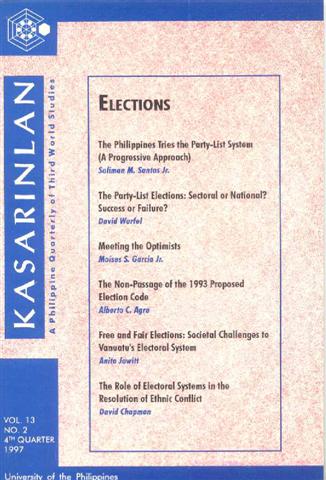The Philippines Tries the Party-List System (A Progressive Perspective)
Abstract
Still reeling from the “effects” of the 1992 synchronized elections that brought forth the none-majority Ramos administration, the Philippine electorate prepares for another first in its tumultuous post-Marcos democratic experience: the party-list system. When the Eleventh Congress opens in July 1998, marginalized and underrepresented sectors, parties, organizations and coalitions shall represent 20 percent of the House of Representatives. But before these various interests join the ranks of traditionally elected Representatives and political parties, they must first bring their cause before the nation's registered voters with meager resources and limited support from the Commission on Elections (COMELEC). An extensive nationwide campaign is needed to convince a personality-oriented electorate that the concepts of democratization and pluralism are worth a second look. There is also the challenge of unifying disparate forces, which appears to be possible only during crisis situations, and the threat of infiltration of major parties, which are always looking for a few extra congressional seats for good measure. Should this "experiment" prove successful in its first run, it could pave the way for an even broader party-list system and a multi-party system that can fully represent all interests in Philippine society.
Published
2007-10-10
How to Cite
SANTOS JR., Soliman.
The Philippines Tries the Party-List System (A Progressive Perspective).
Kasarinlan: Philippine Journal of Third World Studies, [S.l.], v. 13, n. 2, p. 05-18, oct. 2007.
ISSN 2012-080X.
Available at: <https://journals.upd.edu.ph/index.php/kasarinlan/article/view/320>. Date accessed: 29 aug. 2025.
Section
Features
By submitting a manuscript, the authors agree that the exclusive rights to reproduce and distribute the article have been given to the Third World Studies Center.



